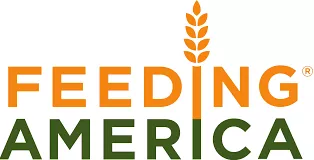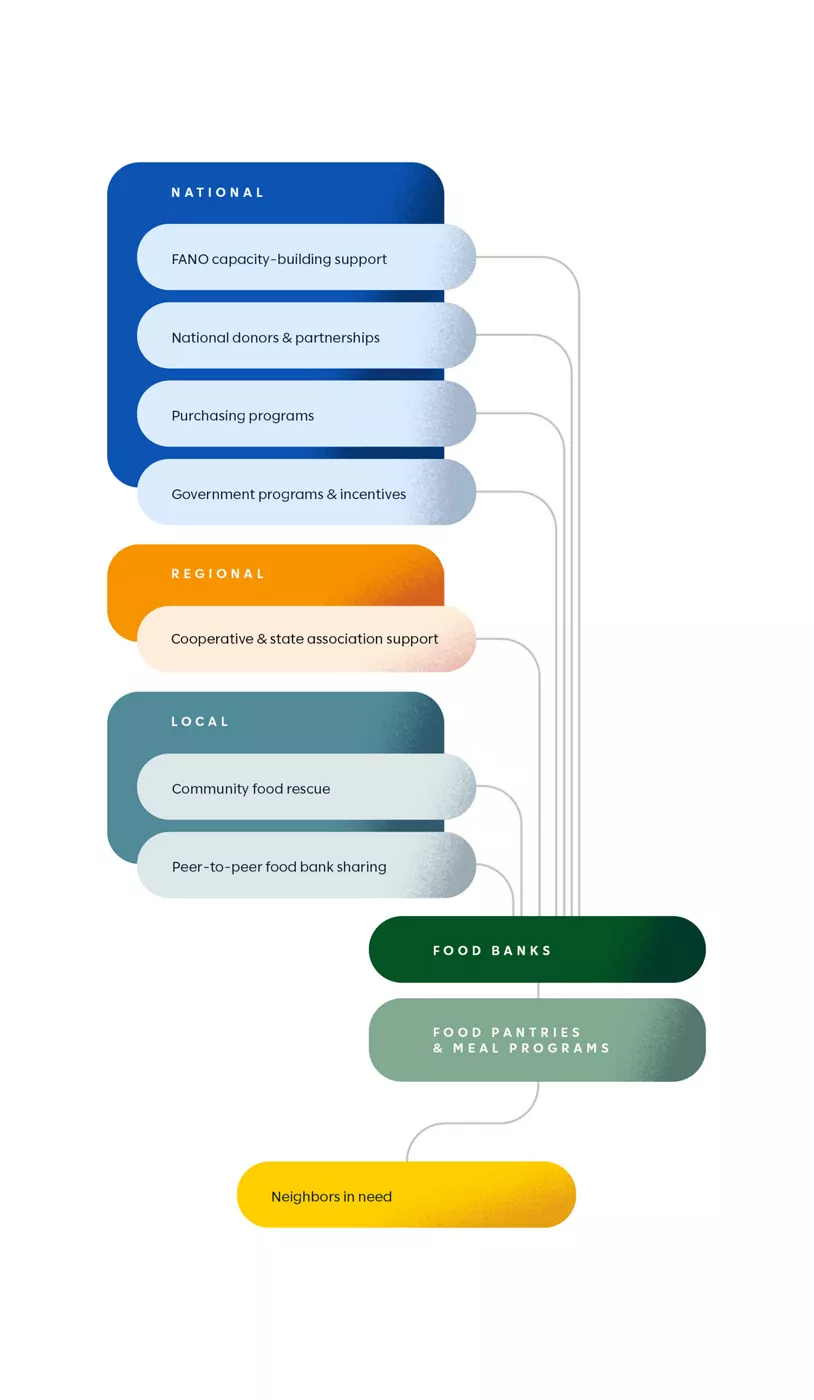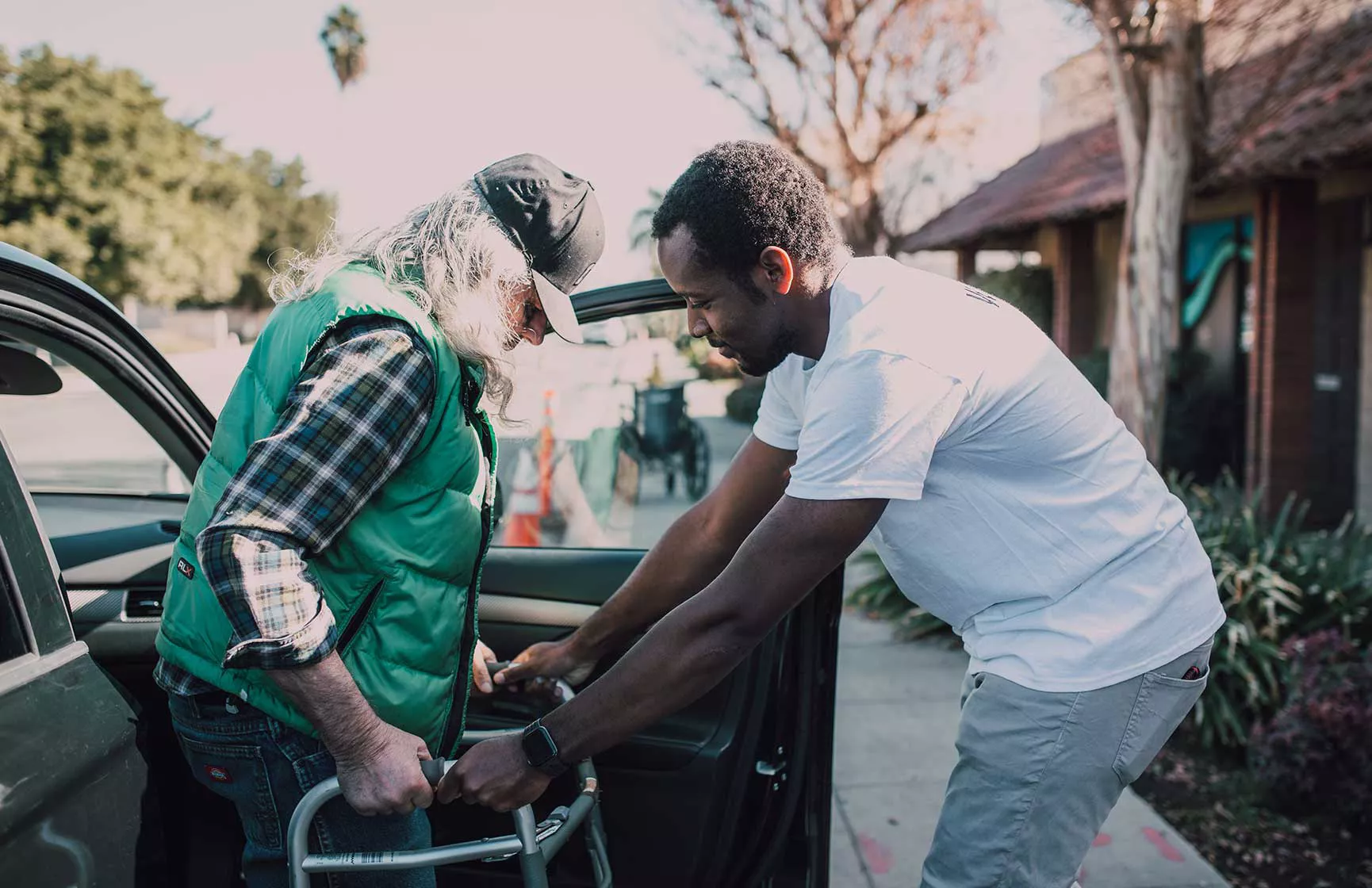
Connecting food banks, ending hunger

At a glance
Feeding America and Slalom are partnering on a multiyear effort that will transform how Feeding America uses data and technology in its national office and across the network of member food banks.
Impact
New ways of working and modernized tools from partners like Salesforce, Google, Microsoft, and Tableau will enable closer connections, mindful growth, and more support for people in need.
Key Services
Industry
Nonprofit & philanthropy
Key Technologies / Platforms
- Microsoft
- Microsoft Azure
- Tableau
- Salesforce
- Google Cloud
In the US, 1 in 5 children are facing hunger
Sit with that figure for a moment. One in five children and approximately 44 million adults and children in total. That’s the magnitude of what Feeding America fights every single day, and the U.S. Department of Agriculture estimates that food insecurity is at its highest level since 2014.
Food bank CEOs like Mike Miller of River Bend Food Bank, Iowa, and Eric Cooper of San Antonio Food Bank, Texas, can paint a vivid picture of the human cost. “Imagine you’re a child sitting in school right now, who doesn’t know where dinner is coming from,” says Miller. “That kid doesn’t care about conjugating a verb or solving for X. They care about when they’re going to eat next. They have just as much capability as anybody else but such a lower chance of succeeding. And there is enough food. We’re just throwing it away.”
A vision of an America where nobody goes hungry
Hunger’s not about a lack of food. The US sends more than 70 billion pounds of food to landfills every year. Feeding America already rescues 3.6 billion pounds of food and is continually working on new ways to get more of that food to the people who need it most.
Feeding America has established a bold aspiration for a better tomorrow – every community and each person within it has access to the food and resources that they say they desire and need to thrive. The food insecurity rate is 5% by 2030 and disparities by race and place are cut in half. But the mission doesn’t stop there. Feeding America is working to end hunger altogether. Its teams take a holistic focus that aims to remove the stigma of hunger and elevate neighbors (people who use its services) out of food insecurity altogether. Talk to the people at the Feeding America National Office (FANO) and the food banks, or to any of the millions of people who volunteer every year, and their passion for the work shines through.
While most of the 200-member food banks and 60,000 agencies in the Feeding America network have their own strategies, leaders, and IT groups, they’re supported by FANO and backed by larger state associations and cooperatives at a regional level. Their work is powered by a large, complex supply chain that serves millions of people every year and makes up 80% of charitable food distribution in the US.


How technology transformation can help
With the leadership of Feeding America’s first-ever CIO Maryann Byrdak and the support of Slalom, Feeding America is undertaking a multiyear transformation that will position data and technology as a true strategic partner in the fight against hunger and food insecurity. At FANO and across the network, Feeding America will be able to leverage its size in new ways, increase collaboration between food banks, improve data sharing, optimize food collection and distribution, learn more about the nature of hunger, and deliver even better services to neighbors.
For Byrdak’s teams, this effort represents major investments and the ability to say yes more often to member food banks. Byrdak says it’s about “opening the door. We’re serious about revamping our portfolio. We’re serious about building the right solutions that provide the most value, and we’re building a team to sustain them.”
“If you want to solve hunger, the goal is to do it at a size and scale that can only be achieved and enhanced through technology,” says Alex Zinicola, a non-profit director at Slalom Chicago who heads up the Slalom project team. “The mission of technology is the mission of the business. Those two are the same.”
A people-centered approach
The Feeding America and Slalom teams embarked on a listening and discovery exercise to understand FANO’s current portfolio, systems, and processes. Then they talked to 30+ food banks to understand what tools they were using and what type of help they would most value.
The discovery identified 160 opportunities. We helped Feeding America group them into 14 program-level ideas, and then a steering committee of food bank leaders (the Feeding America Connect Council) voted to prioritize the right opportunities and create a multiyear roadmap featuring tools that are complementary and easy to adopt and deliver high value at the food bank level.
Building a new foundation
Executing the roadmap will create a modern culture of data, connecting Feeding America’s member food banks and agencies as a true digital network with platforms and tools from a range of partners including Salesforce, Google, Microsoft, and Tableau. The Feeding America and Slalom teams have done much to transform the charitable food system over our three year partnership, including:
- MealConnect food donation and sourcing platform
By connecting retailers with food banks to support local food rescue, Feeding America’s MealConnect platform has already recovered more than five billion pounds of food since 2014—a number that’s set to grow. We used Microsoft Azure Cloud, Azure Identity Services, and Azure DevOps to expand MealConnect to create the first nationally available produce marketplace and matching system, mobile-friendly functionality, and UX with human-centered design features allow food banks to better leverage the size and scale of the network. MealConnect digitally connects large produce donors (i.e., those with truckloads of produce) with the nearest Food Bank. Food donors can donate product from online or their phone into a centralized marketplace for Food Banks to browse, mix and match product to form truck loads, and coordinate all logistics and transportation - including offering and ordering from other Food Bank inventories.
- Understanding neighbors facing food insecurity through Service Insights
Using Microsoft Azure Cloud, Azure Identity Services, and Azure DevOps, we built a national platform called Service Insights to understand our neighbors experiencing hunger and how to best serve them. Used at the point of food distribution, Service Insights is used not only to facilitate food service, but also to understand who is being served (e.g., demographic data for the person and household, travel information, food preferences), but also to alert a neighbor when they qualify for state and/or federal assistance programs like “SNAP”. At the Food Bank and National Office level, Service Insights data are used to place food pantries in areas of greatest need; demonstrate impact as part of grant applications; model demand; support advocacy; and identify the need for culturally appropriate food to meet neighbor preferences.
- Enterprise data warehouse
Built on Google Cloud with Informatica Intelligent Cloud Services for data integration and Tableau for data outputs, the warehouse brings together historically disparate sources and processes in one place. With centralized access to clean, on-time data, FANO will have access to richer insights, more capacity to answer analytical questions and respond to data requests, and the ability to package data in a user-friendly way for members. Supported by our consultants’ advice on data governance and architecture, the warehouse is a future-focused, sustainable solution that can scale with the organization.
- Data sharing and operational dashboards
FANO is encouraging member food banks to connect their ERP platforms to the new data warehouse. This will enable food banks to automate old, manual reporting processes and save countless hours for their analysts, while FANO gleans timely insights about how food is moving through the network and the ability to track trends and capture granular information about the kinds of foods being distributed. As a program incentive, a Tableau Online dashboard is being offered to participating food banks at no cost. Now food bank leaders can see with a glance where their food is being sourced and where (and to whom) it’s being distributed.
- CRM implementation
No more siloed spreadsheets or disconnected conversations! The new CRM built on Salesforce Sales and Service Cloud with Notes and Chatter is a hub for collaboration. A Tableau integration means information from the data warehouse—like statistics on the impact of food banks and donations in a specific location—is available at the click of a mouse. The CRM offers a 360-degree view of how FANO’s teams are engaging with member food banks and helps them share information across the network. Support for programs for seniors and kids, advice on managing federal programs, and advocacy work can all be coordinated using the CRM. And if one food bank has enjoyed success with a program or initiative of their own, it’s easy for FANO teams to pass those insights and ideas to other members.
Together, Slalom and Feeding America are proud to have generated the following impact through our digital transformation:
- Over 300M pounds of produce sourced (and counting), which translates to 217M nutritional meals.
- Sourced produce no longer ends up in landfills, which translates to a reduction of CO2 emissions of over 164M lbs of CO2 emissions or the equivalent of removing 16,000 passenger vehicles from the road for a year
- Over 1 million neighbors have been served using Service Insights
- Connected tens of thousands of neighbors with state and federal assistance programs
- Saved the Network an estimated 150M to-date
Just getting started
With the foundation in place, the future is bright, and Slalom is continuing to partner closely with Feeding America on the transformation.
While much has been accomplished to-date, much remains to be done. Having built nationally available solutions to understand food supply and demand, we are just scratching the surface of what we can do using AI and machine learning capabilities to optimize the charitable food system. For food bank leaders like Miller and Cooper, the results of the work so far and the innovations ahead are exciting. Says Miller, “What if we get visibility o all supply, all inventory, and all demand nationwide? We could be making such better decisions. And what really excites me is the client intake work. Both Eric and I can spout off from memory the volume of pounds of food that have left our buildings every year. We can tell you the number of visits there were to pantries, but we don’t know the number of people who visited, and we don’t know how long they were in need.”
Cooper agrees: “I imagine a day when we’re really connecting people. For example, a coffee chain that might have 10 to 11 pounds of surplus every day at a store level. Why couldn’t the store give it to a senior citizen who lives across the street? In the future, we’re going to have an opportunity to introduce them directly to the corner store or to a grocery store and get out of the middle.”
Transforming futures, changing lives
Transformation work is traditionally measured by efficiencies. Feeding America’s success can and will be gauged by hours saved and food pounds donated, rescued, and shared. More uniquely, it will also be measured by the connections it drives across the network and everything those connections can help food banks do for neighbors.
What could that mean for a child in the classroom or an adult who must choose between putting food on the table and keeping the lights on? Not only improved access to nourishing food—but to human dignity.





